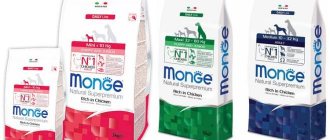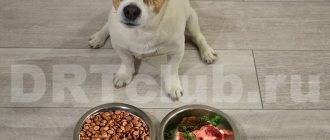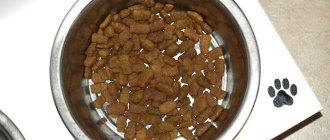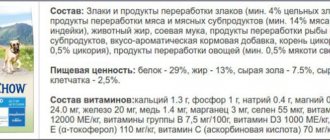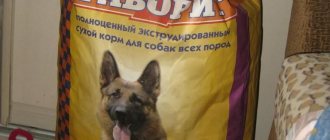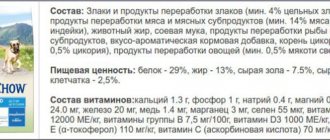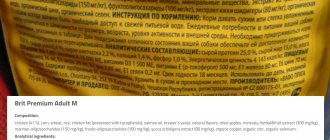July 20, 2020
The answer to the question whether it is possible to mix dry food with regular food - raw or cooked meat, offal, as well as food specially prepared for a dog - or, conversely, to flavor a self-prepared diet with dry food “for taste”, is sought by both novice owners and and experienced breeders who, for some reason, are not satisfied with the results of the diet that they have already chosen for their dogs.
It must be said that there is no clear answer to this question, and everything is not as simple as it seems at first glance. If you try to answer briefly, then under certain conditions this is acceptable, but in most cases it can lead to health problems.
Answer
The lifespan and health of a dog depends on the living conditions and food. The pet’s diet, method and type of feeding depend on various factors:
- age;
- conditions of detention;
- breed characteristics;
- psychological condition;
- presence or absence of physical activity;
- period of pregnancy or lactation;
- recovery period after illness.
Nutrition rules
How does digestion work in dogs? Of course, like a predatory animal. But, in addition to meat and bones, they need vegetables, fruits and herbs. Digestion should begin in the animal’s mouth, but the dog’s teeth can only crush pieces of meat and bones. They are not able to grind other types of food.
The gastrointestinal tract in dogs is short, compared to the gastrointestinal tract of herbivores - complete emptying occurs almost fifteen hours after eating. We can conclude that the stomach microflora for dogs is not as crucial as for herbivores.
But the bacteria that have settled in the cecum deserve a separate word - fermentative ones are especially necessary. It is their lack in the body that forces the animal to eat all sorts of disgusting, in our opinion, objects and creates a deficiency of vitamins in the body.
Conclusion:
- the structure of the dog’s gastrointestinal tract is designed by nature for nutrition, the basis of which (up to 80%) is raw meat;
- the composition of a single serving should be relatively small to prevent overeating and volvulus. Percentage of products: 75 – meat, 25 – cereals, sour milk, vegetables and fruits;
- the dog should be able to chew pieces of food to cleanse the mouth of bacteria, using secreted lysozyme and mechanically;
- bones must be digested by concentrated gastric juice - this indicates its health;
- Almost any meat is suitable for food, even wild animals. The main condition is low fat content;
- nutrition should be regular and balanced, taking into account health, age and physiological state.
Feeding methods
Based on availability of food, feeding animals is divided into 2 methods:
- Free access to food. The dog is not limited in diet; it can eat at any time and as much as it wants. This often leads to excess weight.
- Limit feeding by time and amount of food. Meals are taken at the allotted time and in prescribed portions.
In addition to feeding methods, pet nutrition differs by type of food: dry, wet, natural and mixed food.
Dry diets have their benefits
In terms of saving time and balancing nutrients, industrial diets have a number of undoubted advantages that we value in the modern rhythm of life. In fact, you need to choose food wisely and then just remember to replenish its supplies in a timely manner, give the dog half of its daily requirement twice a day and make sure there is fresh water in the bowl.
The remaining steps are simply omitted, saving the dog owner a tremendous amount of time and effort. Therefore, one can understand a novice amateur who is carried away by the idea of the physiological nature of natural nutrition, but soberly assessing his capabilities and strengths, trying to hedge his bets with dry food. At the same time, when an experienced breeder, who has devoted a lot of effort to developing his own menu, procurement logistics, preparation and storage technology, reads about the ease of life of supporters of ready-made diets, he wants to try, but he is afraid to give up his position. As a rule, this is where the idea of combining two types of nutrition comes from.
Dry food
Dry food is the most popular among dog owners. It is dried and chopped meat, offal in granules with various additives: cereals, vegetables, vitamins, minerals and other additives. The composition of the feed is indicated on the packaging.
Such feeds are divided into 3 classes:
- Economy Cheap ingredients are used in production. They should not be consumed on an ongoing basis, as this affects the growth and development of the skeleton, the condition of the coat and skin, and can cause problems with the digestive tract.
- Custom class. The composition contains synthetic ingredients that can cause allergic reactions in animals.
- Premium An ideal balance of minerals and vitamins for any age, which has a positive effect on the health of the animal. Optimal protein content. Better absorbed by the body.
The main advantage of such food is ease of use. The product is completely balanced and does not require the use of additional vitamin supplements. The food from the package is immediately ready to eat. The stores offer a wide selection of products from different manufacturers, from economy to premium. Another advantage of granules is that due to heat treatment, there are no carriers of infections and parasites left in the meat. The disadvantage of dry food is the presence of synthetic elements in their composition.
Where to look for balance?
Having been involved in the production of dry and canned food for many years and studying the issues of dog nutrition, we can say with confidence that if you choose for your pet a high-quality, balanced diet based on animal protein, which contains enough meat, poultry or fish, then you should be smart and look for compromises you won't have to. We recommend offering your dog one of the Blitz diets with a wide range of flavors, and you will see that the animal is not capricious, looks great and feels good.
Blitz balanced wet and dry diets include quality protein, healthy fats, vitamins, minerals, fiber, and probiotics. You can be sure that your pet will receive all the necessary nutrients with them, because the formulation of our products meets the needs of dogs as a biological species, they are all complete and suitable for daily consumption.
And if you still want to pamper your pet with something special, then pamper it in a way that will benefit the dog! Consider our delicious Blitz Canned Dog Foods, which are also complete meals. The excellent composition and clear dosage on the packaging will allow you to correctly combine them with Blitz dry diets without disturbing the nutritional balance. This is a fundamentally important point!
We hope that our arguments on the question of whether dogs can have mixed food have convinced you, but if you have any questions, you can ask our consultants directly on the website or on Blitz social networks, we are always happy to help!
Wet food
Wet food is also a completely finished product with a large assortment: canned food, jellies, pates. Compared to granules, wet food has the following advantages:
- a variety of tastes close to natural;
- The portion is intended for 1 serving;
- additional source of moisture;
- lower calorie content.
Wet food also has its disadvantages: it quickly deteriorates in open packaging and costs more than granules. In addition, the cost of canned food is higher.
You cannot keep your pet on wet food only - this leads to dental problems. The granules perfectly clean tartar. For this reason, veterinarians recommend combining dry and wet food.
What happens in the stomach?
The worst way to combine “natural” and dry food is to mix them in one bowl, since the rate of digestion of dehydrated and wet foods is not the same. Once in the stomach, food granules first absorb liquid and swell, while natural products do not need this. By offering the puppy this dubious mix at one feeding, we increase the likelihood that some of the food will end up in the intestines insufficiently digested. The result will be a decrease in the absorption of nutrients, which over time can lead to a lack of certain elements in the animal’s body.
Sometimes the consequences occur immediately - increased gas formation, vomiting and upset stool occur.
Natural food
A common misconception among novice dog breeders is that natural food is food from the owner’s table. This is wrong. The basis of the diet for this diet is meat (including offal), fermented milk products, cereals and vegetables. You should not combine meat and vegetable foods with fermented milk products in one meal.
The advantages of natural food are freshness, taste and the absence of preservatives and artificial colors. Of course, such food is beneficial for the animal.
The main difficulty when choosing this type of nutrition is choosing the right diet. For selection, it is better to contact a veterinary nutritionist. Another problem that arises in the city is finding high-quality and fresh products without harmful additives.
Cooking food with this diet takes longer.
In what cases is mixed feeding of dogs acceptable?
Is it possible to feed a dog raw meat or is it better to cook it?
Of course, most veterinarians are not very fond of mixing food, but note that in some cases alternating the diet is quite acceptable:
- feeding puppies in foster homes. Usually cottage cheese and raw meat are added to dry granules. In this case, the puppy’s gastrointestinal tract will adapt to several types of food at once. Professional breeders do not do this because they do not know what diet the future owners will adhere to;
- Large, hunting or sporting breeds need additional protein in their diet. For example, Labradors, Rottweilers, or Shepherds are fed meat, fish, or offal;
- A whelping dog or breeding dog also needs adequate nutrition before mating. During this period, the animal needs a balanced, varied diet, and only natural food will help restore this deficiency;
- if the dog is picky about food or eats little. For example, from meat porridge the animal chooses only meat, while vegetables and cereals remain in the plate. In this case, you can add special granules for variety;
- during vacation or on a train trip, the owner does not have the time or opportunity to prepare natural food for the pet, so in this case, ready-made food would be a good alternative.
Note! The granules in the animal's stomach swell, so if the animal eats both natural and dry food in one meal, this will slow down the digestion process, and the dog may have digestive problems.
Feeding rules and acceptable products
If granulated food has been chosen as the basis for your dog’s diet, then it is recommended to know the feeding rules and acceptable foods. The following natural foods are allowed as a supplement to the main diet:
- fresh vegetables, fruits, berries, herbs;
- cottage cheese, fermented milk products;
- raw meat, liver, sea fish;
- quail or chicken eggs.
Natural food should be given a separate meal, for example, given only in the evening. There should be at least 5 hours between the consumption of dry and regular foods.
How much water does a dog need?
The second important question after choosing a diet for your pet is how much water the dog needs. There is no exact amount, it varies depending on nutrition:
- dry food - a lot of liquid, since there is almost no moisture in the granules;
- mixed feeding - moderate amounts of water;
- natural food - drinking regime according to the pet’s needs, since the food is saturated with moisture.
The only rule is that the bowl should always be filled with clean water. It must be changed every day, thoroughly washing the container.
There is still no general consensus on mixed feeding, as there is no convincing evidence for or against this type of diet. If you want to feed your pet a combination of dry and natural products, the main recommendations are to follow the feeding rules and include only acceptable products.
I am not a “fan” of dry food, so we will talk about natural and mixed food. All the talk about the dangers of mixed nutrition is a myth, invented, I think, by commercial feed manufacturers. The only thing you need to keep in mind if you choose a mixed diet is that you should never feed dry food with “natural” ingredients (an exception may be kefir). Dry food is given as a separate feeding.
Feeding regimen: Up to 4 – 5 months – 4 times a day. From 5 months to 1 year – 3 times a day. After 1 year - 2 times a day.
Meat – raw beef. Don't give minced meat. The dog has a short digestive tract, so the minced meat will “slip through” very quickly and will not have time to be absorbed. Cut the meat into pieces. Don't buy so-called "trimmings". The muscular part of the leg is desirable. In the market it is called goulash or cutlet meat. In terms of amino acid composition, this is the best meat for dogs.
The amount of protein in the diet is very important. If there is not enough of it, the puppy will not receive the necessary “building material”. And its excess will lead to hypervitaminosis (allergies, eczema, etc.) and leaching of calcium from the bones. We calculate this way: if you feed only “natural” food, then the puppy receives meat per day: at 2 months - 200g, at 3 months. – 300g, at 4 months. – 400g. etc. up to 500-600g. per day throughout life (mating males and working dogs during the hunting period should receive at least 700g). Bitches should eat 300-400 g per day.
But if the diet is mixed, i.e. If the diet contains dry food (pre-soaked for 10-15 minutes in warm, not hot water), then the above-mentioned meat allowance is halved.
Give the meat with porridge (any cereal except semolina and pearl barley, the main cereals are buckwheat and rice ) and stewed/boiled (not raw) vegetables: pumpkin, carrots, zucchini , etc. Do not overuse cabbage and legumes, it will cause swelling. It is good to use frozen vegetables - add them to the pan before the end of cooking the porridge. The porridge can be cooked immediately for 3-4 days and kept in the refrigerator. Before giving it to your puppy, add a little boiling water to the porridge and stir so that the food is not very cold. It is also unacceptable to give hot food. Add 1 tsp to the bowl with meat and porridge. sunflower or olive oil. Now they are selling pumpkin oil .
raw tripe once a week instead of meat - this is a real storehouse of vitamins and microelements. After 6 months, you can sometimes give offal (chicken stomachs, chicken and beef heart), but don’t get carried away. Never give udders and lungs. Beef liver can cause loose stools. Chicken, turkey and fish (sea fish only) – boiled. Sometimes, raw chicken necks can be given as a treat. There should be 1.5 times more fish than meat, because... it contains less protein. Cottage cheese (no more than 9% fat). low-fat kefir to it . egg with its shell into a lactic acid bowl 2 times a week . If chicken, then without protein (chicken protein can cause allergies).
Feeding to strengthen ligaments is one raw chicken wing per day. The first 3-4 days only the last phalanx. Then connect the second phalanx. After 4 months - the whole wing.
Vitamins and mineral supplements with adequate feeding, as recommended above, can only disrupt the metabolism and phosphorus-calcium balance in the body. These medications are needed only when indicated. This is why proper nutrition is so important. A dog, as a carnivorous animal, gets all the necessary vitamins and microelements from raw meat!
Never give bones, boiled ones are especially dangerous, because... they are not processed by gastric juice and remain in the stomach as ballast. Bone fragments can disfigure the entire digestive tract and cause the death of a dog!
That, in fact, is all about feeding. It is very important to learn how to determine the condition of your dog. A Labrador absolutely has no right to be thin, with protruding ribs and spine, sunken groins and a slender waist! But turning him into a piglet is also unacceptable! Visually assess your dog daily and correct its condition with the amount of porridge, but not meat or food. Don't forget about the consequences of too little or too much protein!
| From the site labradorlife.ru |
